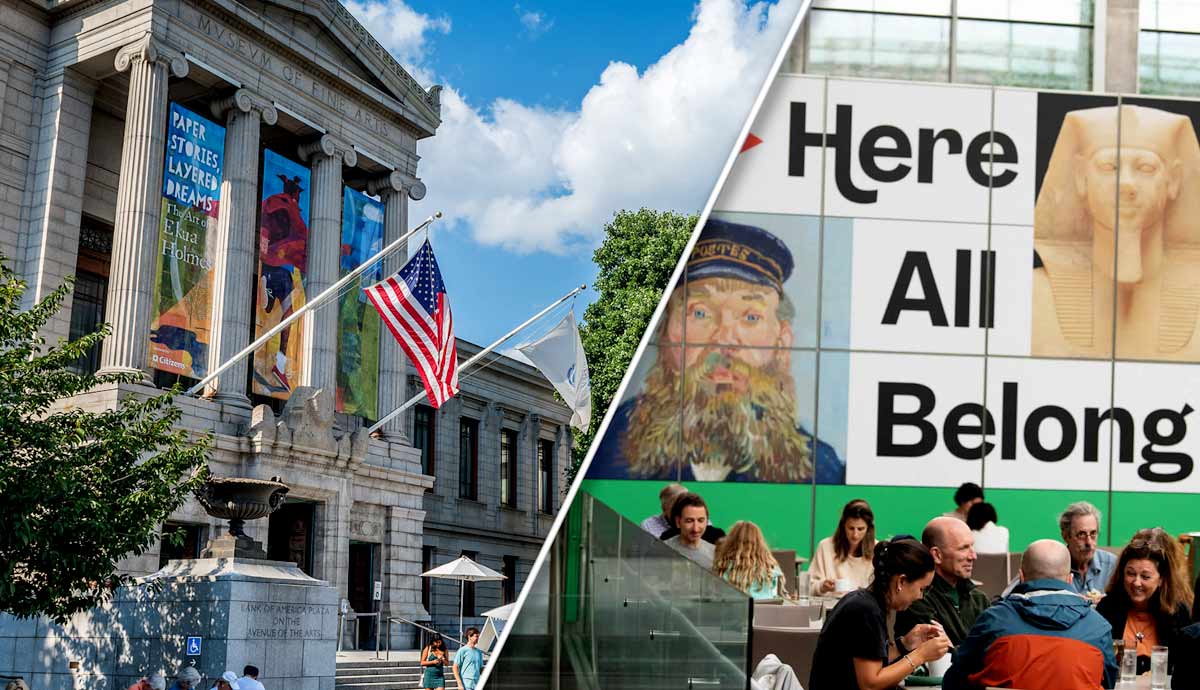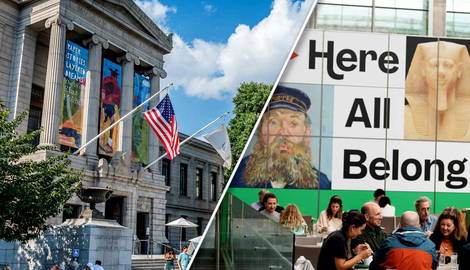
The Boston Museum of Fine Arts, Boston (BMFA) prides itself on embracing fresh perspectives in an inclusive space. It is a museum where you can broaden your horizons, feed your soul, and feast your eyes on artistic highlights from throughout the millennia. From ancient artisanship to meandering through the Middle Ages to classical masterpieces and contemporary visionaries, there’s something for everyone at the MFA.
The Boston Museum of Fine Arts boasts an extensive collection of nearly 500,000 works. It showcases the development of humanity since the dawn of time, displaying our beginnings while providing a compass for the future.
1. Ancient Wonders

The ancient world was filled with breathtaking art that rivals modern creations. To think that these cultures did not have the tools, know-how, or technology we have today makes it even more worthy of a visit.
Ancient Egypt in particular has captivated the imagination of countless generations through the ages and still does. With over 65,000 objects, the Boston Museum of Fine Arts’s Art of Ancient Egypt, Nubia, and the Near East department houses an exhaustive collection.
Almost anything you can think of appears in the collection, which spans from around 6500 BCE to 600 CE, including jewelry, coffins, mummies, canopic jars, weapons, musical instruments, and mosaics, to name just a few objects.

The ancient Egyptians were a death-positive nation. They pursued immortality through elaborate burial rituals and preserving the body through mummification. The MFA’s Mummy Egypt: Funerary Arts exhibit (in Gallery 109) houses over 140 artifacts from 1700 BCE to 300 CE and shows the journey everyone’s soul undertook to reach and enjoy the afterlife.
The exhibition showcases the religious and cultural aspects surrounding the Egyptians’ quest for immortality. It makes us question our mortality while providing a window to the past. Two exceptional highlights to look out for include the painted cedar coffins of Governor Djehutynakht and his wife and the sarcophagus of Thutmose I, discovered in the Valley of the Kings by Howard Carter in 1903–4.

You’re also spoiled for choice when you step into Gallery 110, which houses the museum’s Ancient Near Eastern Art. Highlights to look out for include reliefs from the palaces at Nimrud and Nineveh. A popular favorite is the glazed brick panel of a life-size striding lion from the Processional Way from the Ishtar Gate to the Temple of Marduk, Babylon. The gallery contains important objects from Anatolia, the Levant, Mesopotamia, and Persia.
Expect to see many objects ranging from rolling seals, coins, jewelry, and reliefs. You can also view the head of the demon Pazuzu, whom women summoned to protect them against the evil Lamashtu.
Art of Ancient Greece, Rome, and the Byzantine Empire

Four galleries are dedicated to over 17,000 works from about 2800 BCE (the Bronze Age) to 600 CE (the Byzantine Era). Ancient Greek art was influenced by Egyptian art but was taken to new heights.
A particular highlight of the collection is the newly imagined space dedicated to Greek and Roman gods and goddesses. Here, you can see depictions of the heroes from classical mythology come to life — “putting a name to a face” and bringing them closer to our own time.

With a collection spanning more than 3,000 years, the museum offers an overview of ancient Greece’s finest achievements across various media. From fine marble sculptures to painted vases to metalworking and jewelry, there’s something to view around every corner. Other natural materials like clay, precious stones, and metals are also represented in the collection.

Western portraiture has its roots in ancient Rome, where it played a role in constructing and maintaining identity — much like it does today. These portraits are more than just vanity projects or recording someone’s appearance. They were used as propaganda and self-promotion pieces (where these ideas started) but also adorned private homes, tombs, and public buildings. Roman portraits give us an intimate look into these nation’s lives and how they lived.
2. The Art of Asia

The Art of Asia galleries reflect on art from 4000 BCE to the present and represent works from China, the Islamic world, Japan, Korea, and South and Southeast Asia. The collection comprises over 115,000 artifacts and celebrates 150 years of exchanges between America and Asia.

The Chinese collection features objects from nearly every Chinese historical dynasty, such as imperial ceramics, ancient bronzes, and giant Buddhist sculptures. Twentieth-century contemporary artworks are also on view.
Additionally, the Boston Museum of Fine Arts is the first museum in the USA to put together a collection of South Asian art. Objects are from places like the Indus Valley Civilization, Vietnam, Indonesia, Thailand, Myanmar (Burma), and Cambodia — ritual objects from the Himalayan regions and essential Buddhist and Hindu sculptures. The BMFA also houses the most extensive collection of Vietnamese ceramics in the USA.

The collection features three different bodhisattva statues from three different periods: ca. 530 CE, 580 CE, and the twelfth century CE (pictured first). These massive statues, the oldest and tallest measuring 77 inches (196.5 m), show the development of the artisan’s craft through the ages. When you look closely at them, you’ll notice the fine, detailed, and three-dimensional carving striving to portray features and the clothing’s folds.

The Islamic collection is also one of the pre-eminent collections found in America, with objects ranging from ancient to modern times. Islamic art is highly religious by nature. The art spans various centuries, countries, and rulers. Like a golden thread, multiple unifying elements like Islamic calligraphy, artisanship, and themes run through the works. Numerous countries’ art is present, including Egypt, Iran, and Türkiye.
3. The Art of Europe: Creativity Knew No Bounds

The Art of Europe collection boasts more than 21,000 artworks, from paintings to sculptures and decorative. The BMFA’s holdings represent art from the Middle Ages to the mid-twentieth century.
Netherlandish Art: Step Into the Dutch Golden Age (and Beyond)

From the beginning of the Renaissance (end of the Middle Ages) to the eighteenth century, the Netherlands spanned across modern-day Belgium, Luxembourg, and the Netherlands. It was an important artistic center whose influence would resonate throughout Europe. The Dutch Republic, with its vast global trade network nourishing its vibrant economy and innovative stock market, entered its Golden Age (ca. 1625–75). Some of the most important names to seek out in the Boston Museum of Fine Arts’s collection include Rembrandt, Paul Peter Rubens, and Antony van Dyck.
Kunstkammer Gallery: One Person’s Vanity Project, Our Visual Delight

The Boston Museum of Fine Arts’s Kunstkammer, or Alyce Morrissey Gallery (Gallery 143), is a small gallery in the style of a fashionable European royal or noble’s own “art room.” These rooms were trendy during the 17th century, helping Europeans to show off their collecting prowess (i.e., wealth and vanity) and command over nature and the arts.
Usually, these rooms would contain exotic natural objects and manufactured treasures. These rooms were also a microcosm of the known world. The BMFA’s Kunstkammer features exotic materials like amber and ivory fashioned into intricate artworks, coconut and nautilus shells, hard stone, and copper. A definite delight is the Diana and Stag Automaton (automatic machine), which you can see crisscrossing a table, via video.
Impressionism and the Largest Monet Collection Outside France

Several major themes are on display in the Sidney and Esther Rabb Gallery (Gallery 225), including a look at the modern urban experience in Paris, which casts an eye on a rapidly evolving world and its impact on the city and its inhabitants. Artists in this line of thought include Monet, Signac, and Sisley.
Other artists like Gauguin, Renoir, and Van Gogh sought inspiration away from the hustle and bustle of the Parisian boulevards, in the countryside, or further afield in exotic locations overseas. The Boston Museum of Fine Arts boasts the most extensive collection of Monet’s paintings outside of his native France.
4. Art of the Americas: Ancient Nations and the Birth of a New Nation

The Art of the Americas galleries span millennia, cultures, geographies, and artistic media, from ancient art from before European contact, to the earliest art created by European settlers in New England. The Native North American Art Gallery focuses on the Indigenous experience, cultural exchanges, and resilience.
There is also art from the time of the American Revolutionary War, which focuses on questioning the role of the arts in constructing national identity in the newly formed United States of America. Paintings, sculptures, and decorative arts consider how artists dealt with the trauma of the Civil War. Highlights include John Singer Sargent’s The Daughters of Edward Darley Boit (pictured above).

A collection from the ancient Americas reflects the sophisticated and diverse artisanal objects from before European contact. The collection spans over 2,000 years and expresses these nations’ cultural, political, and spiritual concerns, hopes, and aspirations.
Highlights to look out for in the Pre-Columbian Gold and Andean Civilizations Gallery, which includes pottery, textiles, gold, and jade creations. These nations lived in close harmony with nature, which is reflected in many artworks. The countries represented are from South America and Mesoamerica (today Central America).
Artists of African Descent: Including Underrepresented Artists

The Boston Museum of Fine Arts’s mission is to foster an inclusive space for everyone regardless of race, identity, religion, or background. The Boston MFA strives to exhibit
“… historically underrepresented [artists]—among them women and LGBTQ+ artists, Black artists and artists of color, self-taught and folk artists, and Indigenous and Latin American artists. This diverse artistic vision challenges assumptions and inspires fresh ways of thinking about the art, culture, and history of the Americas.”
Since the 1990s, more than 125 works by artists of African descent have been acquired to highlight these artists’ integral part in art history. Artists from across the African diaspora, including Afro-Caribbean and Afro-Brazilian artists, are included in the collections.
5. Musical Instruments: What Is Life Without a Good Tune?

With more than 1,100 instruments in their collection, the MFA’s exhibits span nations, continents, and centuries. Numerous examples from Asia, the Middle East, Africa, America, and Europe are represented.
Visitors can learn more about the instruments through live demonstrations, recorded audio samples, concerts, and live examples. Instruments from ancient times to the late 20th century make this one of the must-see galleries to learn about other cultures and their musical practices.










